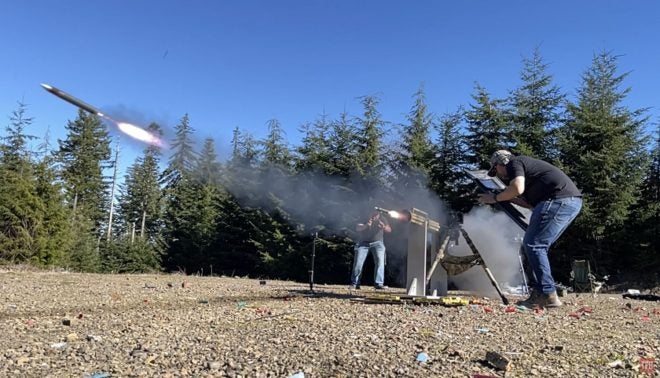If you recall, John (Rocketman) Wild filed Form 1 and made a destructive device (DD). But not just any DD, he made a Panzerfaust! Well, John was not content to sit on his laurels and bask in his own awesomeness. He decided he needed a new challenge. He built a Fliegerfaust. A nine-barreled rocket launcher that was originally designed and developed at the end of WWII by Germany. We were fortunate enough to be invited to document the test firing of his DIY Fliegerfaust and be part of history.
John Wild @ TFB:
- Form 1 DIY Panzerfaust
- “Expedient Recoilless Launcher: Panzerfaust” Book now Available
- TFB B-Side Podcast: Talking Recoilless Launchers with Johnny Wild
What Is a Fliegerfaust?
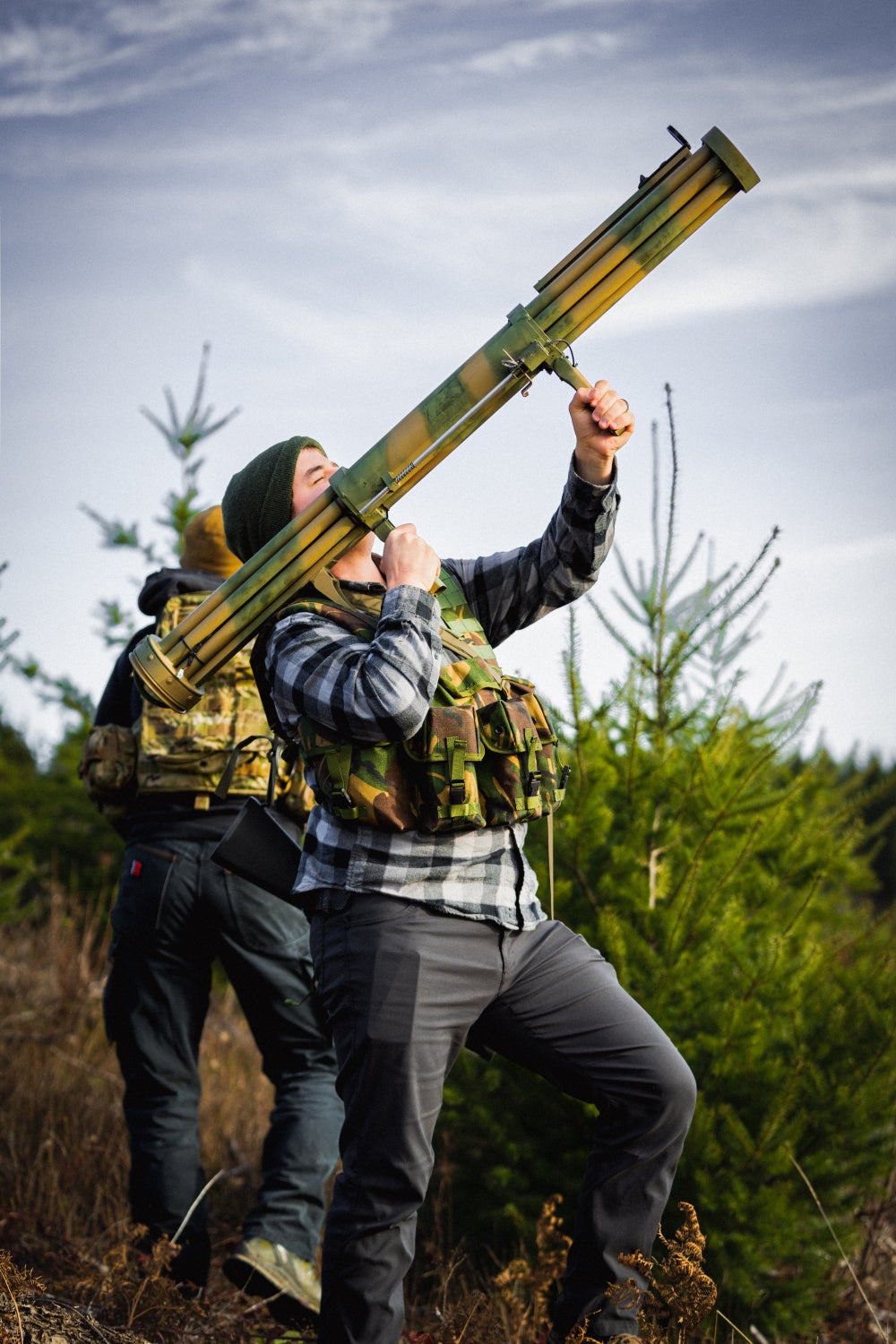
Photo by John Wild
Many people may recognize it from some first-person video games like Battlefield. In real life, it is a nine-shot/barreled rocket launcher that launches nine 20mm rockets. It was developed as an anti-aircraft man-portable device. It fires rockets that do not have fins but rather four angled holes in the back so the exhaust would cause the rocket to spin thus stabilizing it. The Fliegerfaust was not successful partially due to Germany losing the war and development ceased. However, this did not stop John Wild from making his own functional replica.
Documenting History: Test Firing A Home Made Fliegerfaust
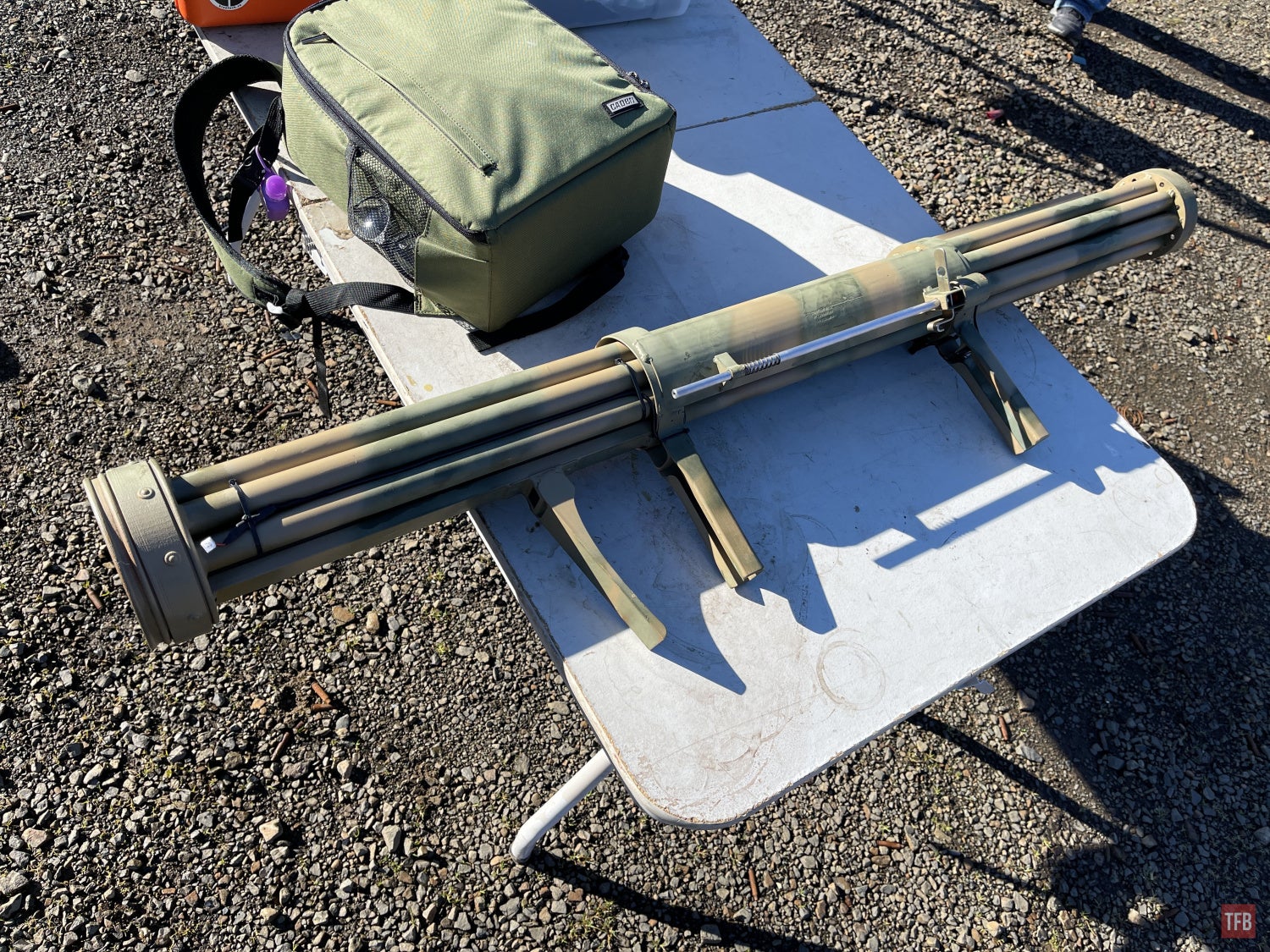
Last fall I reached out to John Wild and offered to help document his homemade rocket launcher using my Chronos 1.4 high-speed camera. Due to scheduling conflicts and the fact he had his firstborn last month, we finally settled on test firing and filming the Fliegerfaust. Lucas D and I were there to help and film.
Details Of The Launcher
Some parts of the Fliegerfasut launcher were made with 3D-printed steel. The grip you see below was 3D printed.

The trigger mechanism was also 3D printed in metal.
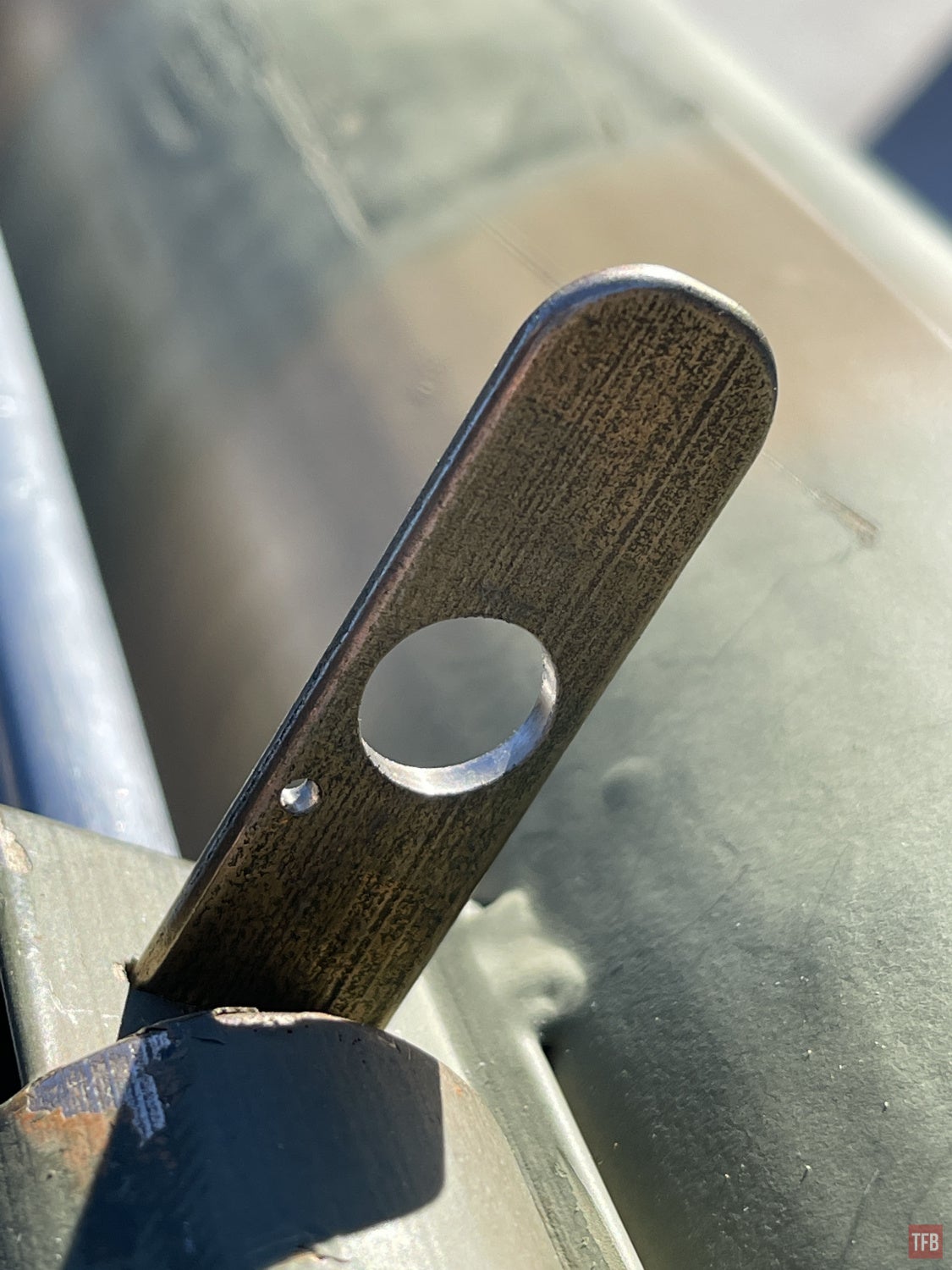
You pull the bar downward and the hole lines up with the spring-loaded rod behind it. The hole allows the rod to spring forward and hit the electronic switch which then sets off the 9x e-matches.

The rear shroud/locking ring was also 3D printed.
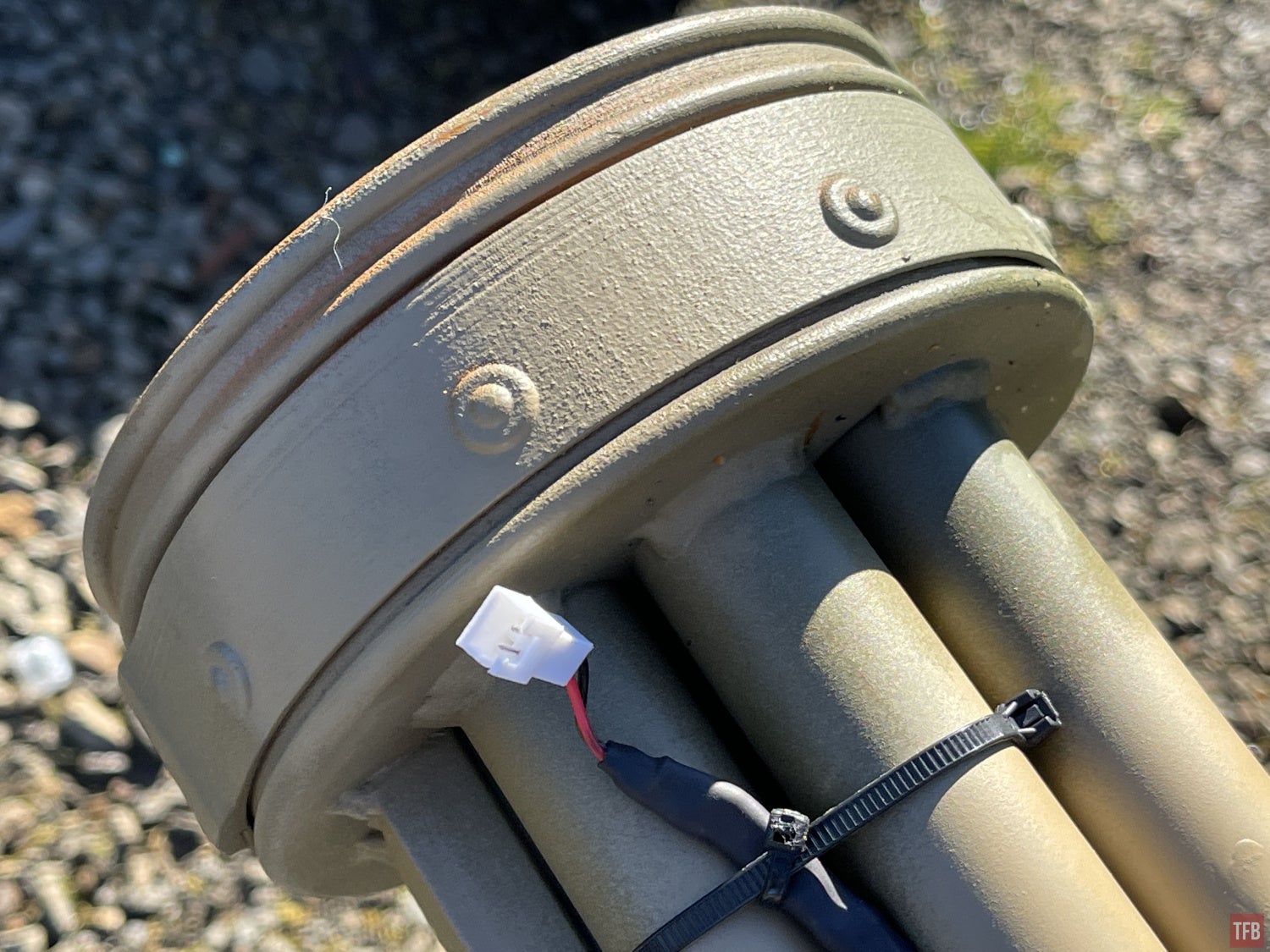
John told us there were some issues welding the 3D-printed steel. It has too much bronze content and made the wending process difficult.

Loading The Rockets
Even though neither the rocket fuel nor the igniters are considered explosives and none of his projectiles have explosives; John decided to follow ATF recommendations and load all his ammunition on the day of launch and expended all remaining ammunition before leaving the site.
Below is a photo of the rocket nozzle. See the angled holes? That is what helps spin the rockets. The white clip is to connect an e-match (electric match) to the ignition system. John uses e-matches to ignite the rocket fuel. He says it is the only approved igniter by the ATF.

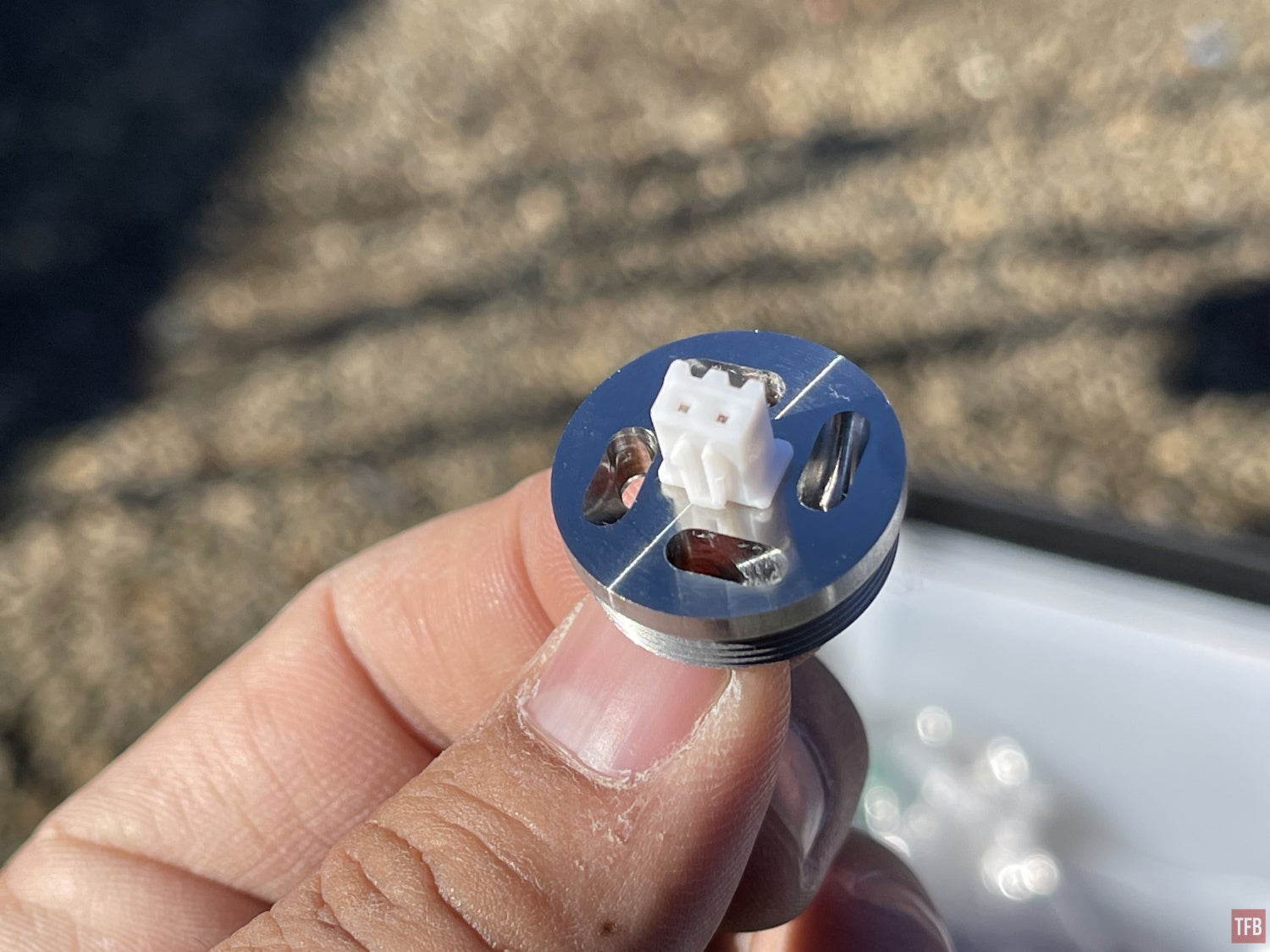
This is the rocket clip. It is like a moon clip but for nine 20mm rockets.

The rocket fuel is a homemade concoction with the help of a rocket enthusiast. It is a formula used for model rocketry. I bet you never thought amateur rocketry could be this cool, right?
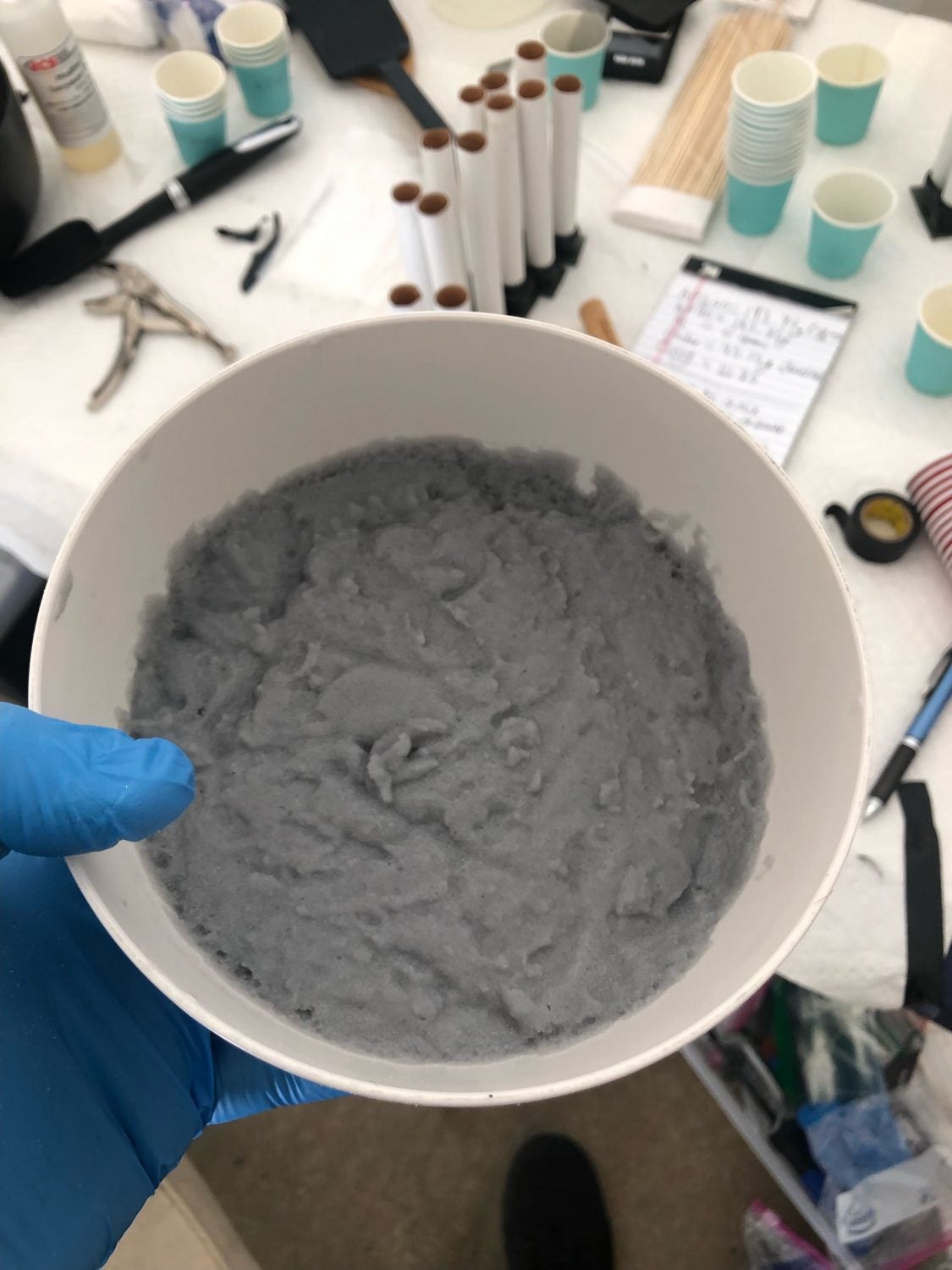
Photo by John Wild

Photo by John Wild
Once the rocket fuel was made, John formed them into cylinders. He then cored each cylinder so they are hollow. This increases the burn rate so they burn faster.
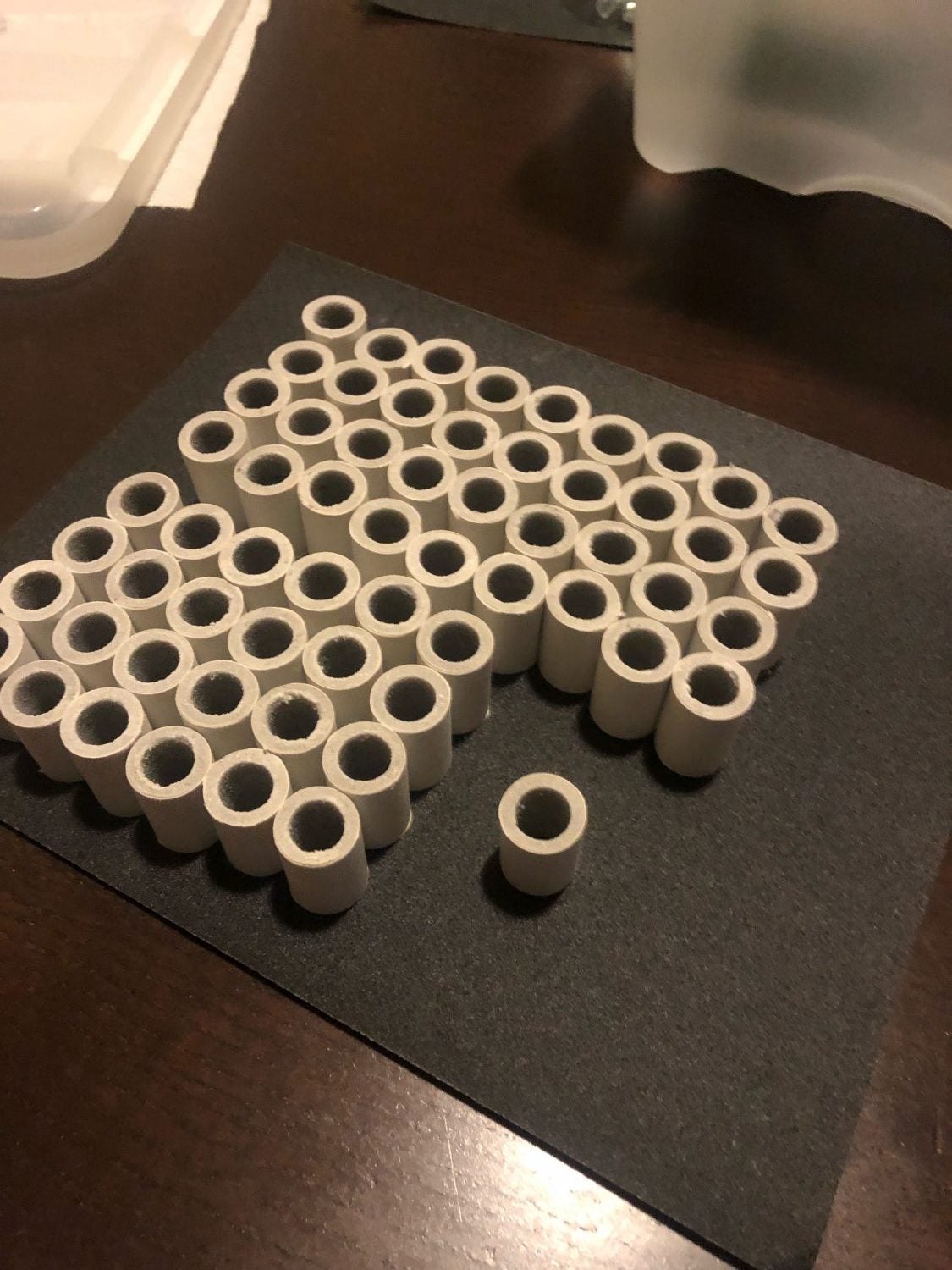
Photo by John Wild
On the day of launch, he measures the OAL of four homemade rocket motors. If they are too long he needs to trim them to fit in the rocket.

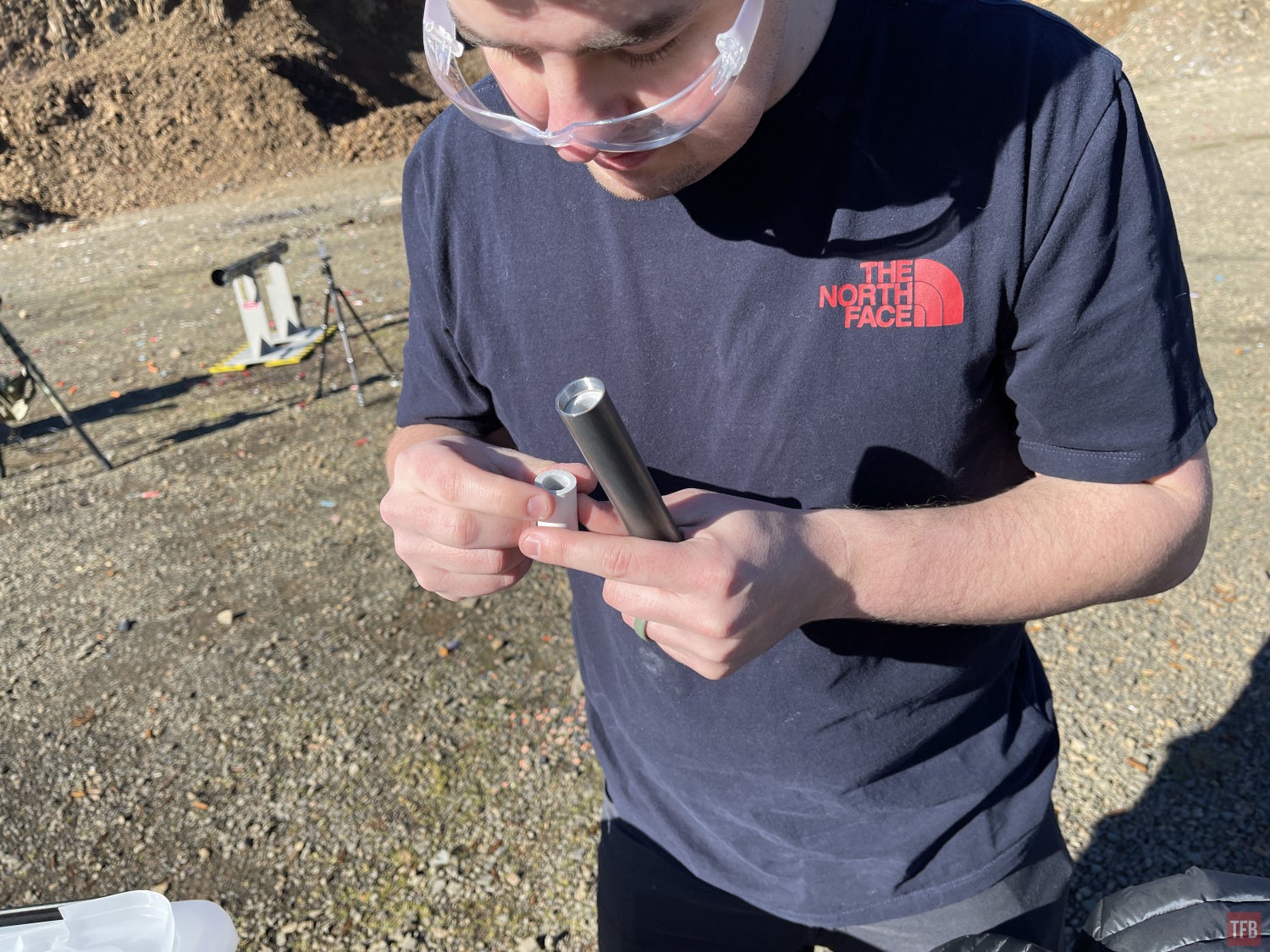
John also inspects each motor for discoloration. See below. See that dark spot inside the motor? That could cause inconsistent burning so he did not use that one.
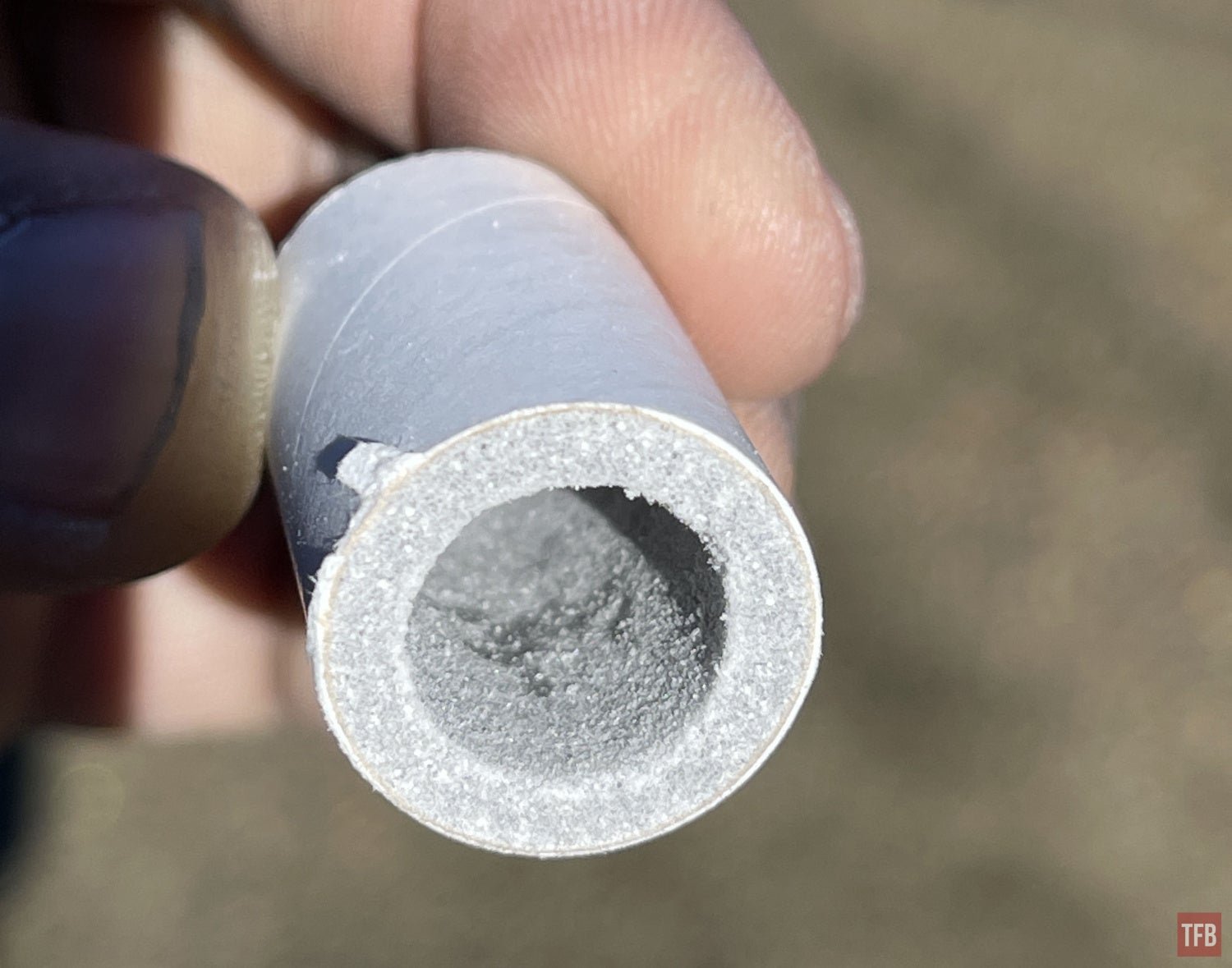
In order to maximize the efficacy of the e-match, John cuts up rocket fuel to increase surface area and wraps it around the e-match.


Real men cut and take a hit of rocket fuel to start the day. LOL

Here is one of the 20mm rockets.
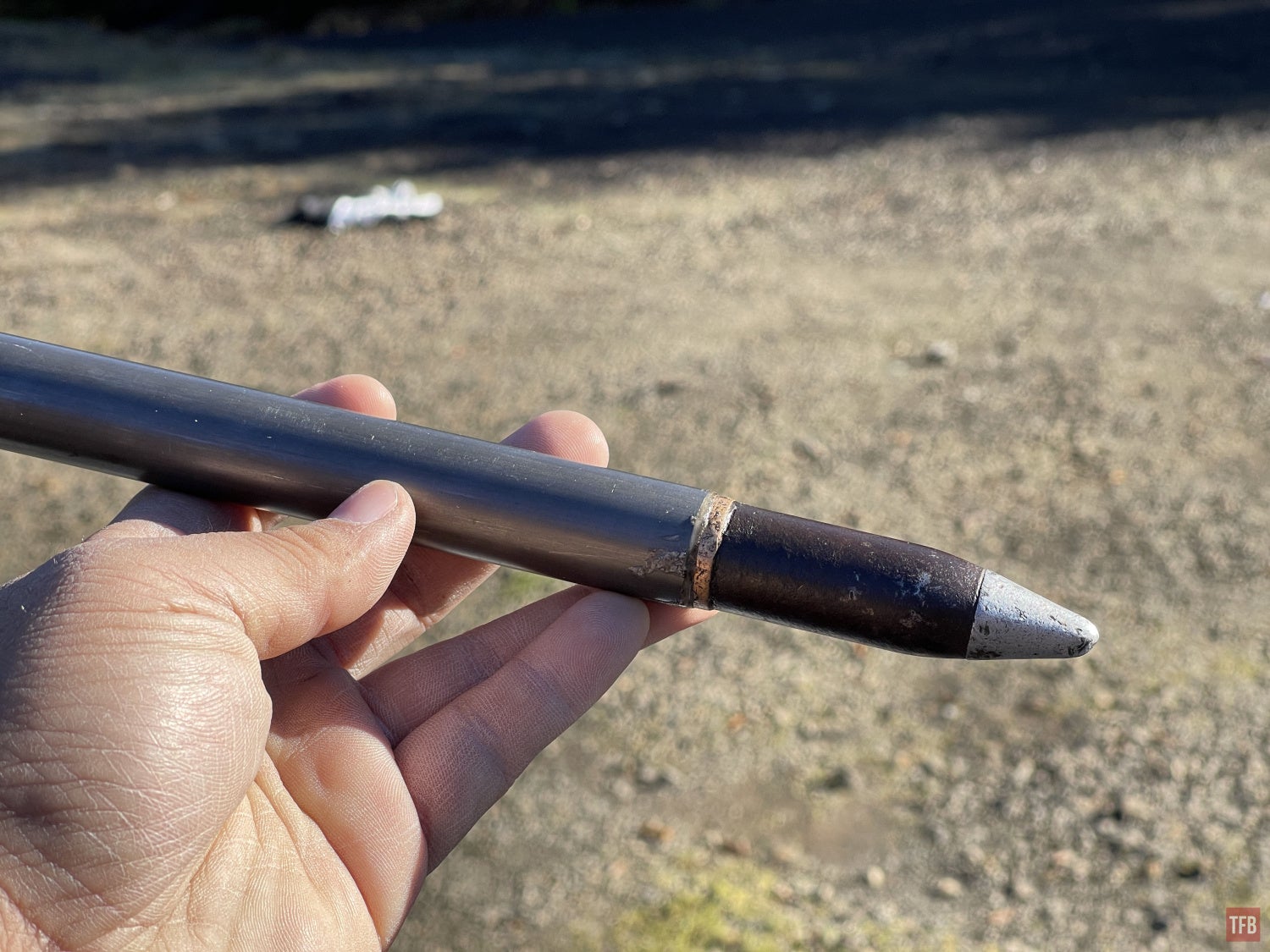
John had two different lengths of projectiles. The shorter ones are 100 grams each while the longer ones are 130 grams each.

Loading The Launcher For Single Fire Test
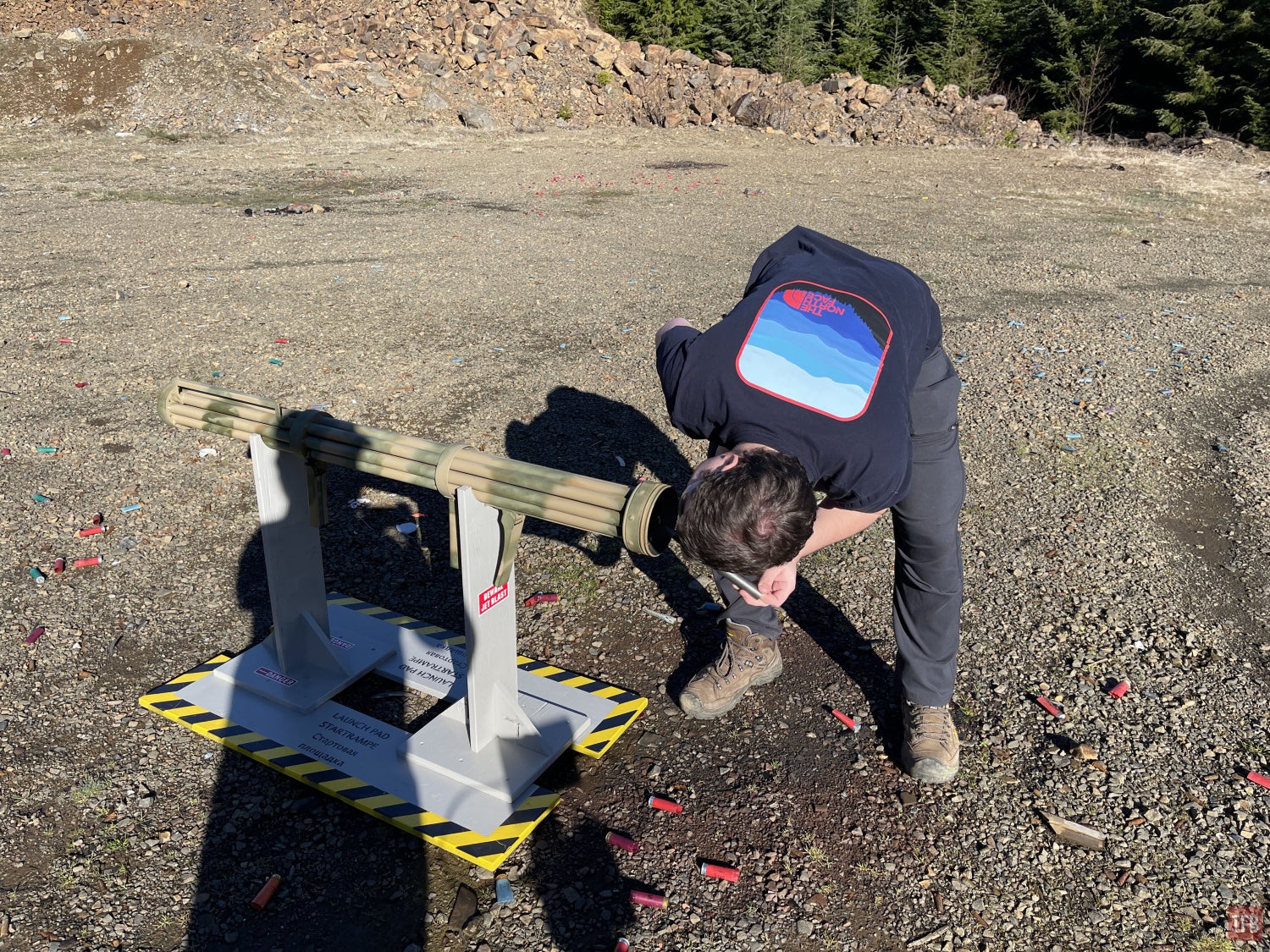
John checks for barrel obstructions.

Not your typical proctology exam.
Since John hasn’t tested this launcher, he decided to perform incremental tests.
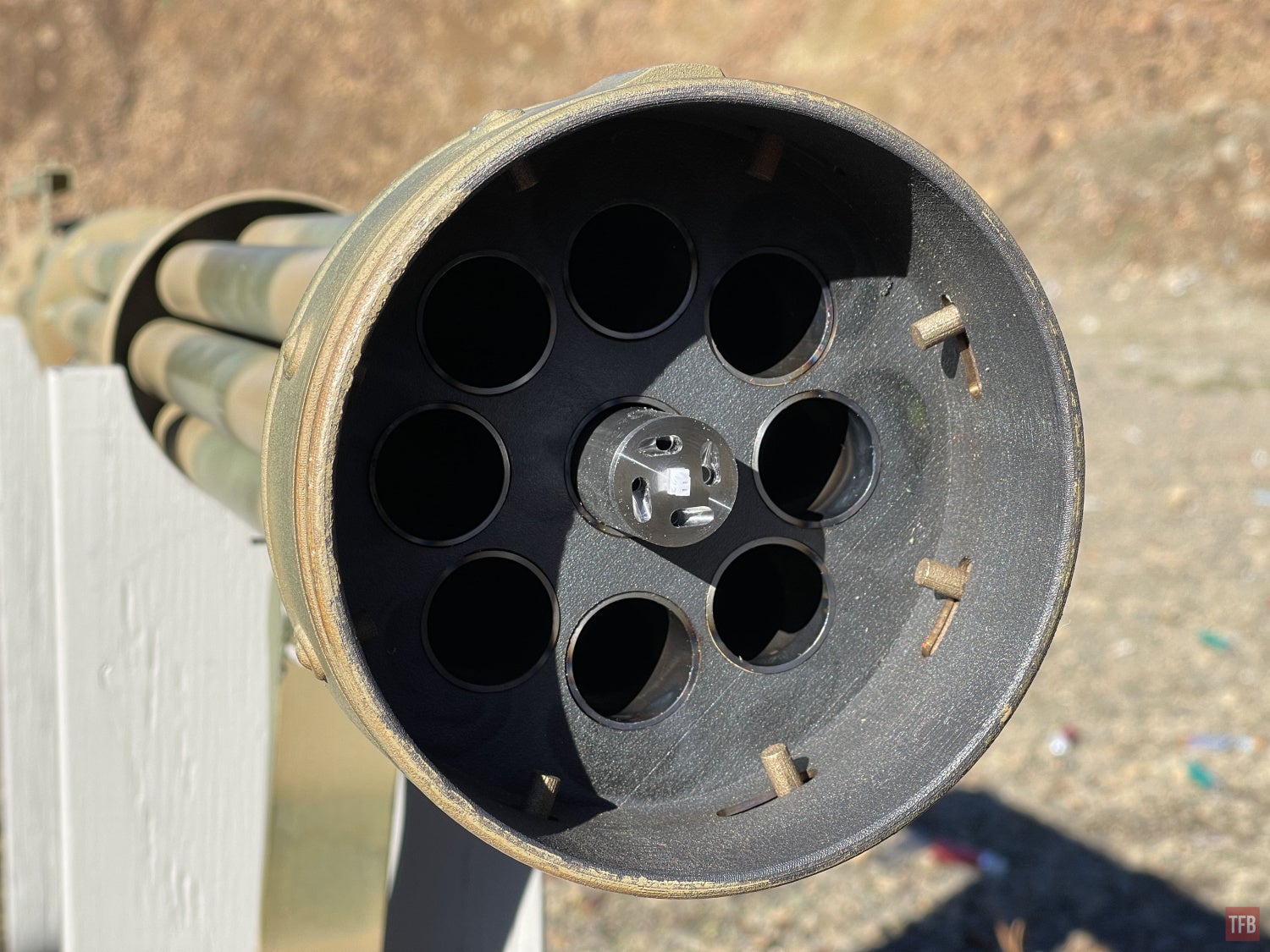

For safety reasons, John set up the rockets to fire remotely with this ignition system. It consists of three 9v batteries and a push-button switch. The three 9V batteries are due to getting more reliable ignition with nine e-matches. From his early tests, a single nor a second battery was enough to ignite all 9 at once.

I filmed the first rocket test fire with my Chronos 1.4 slow-motion camera. See the video below. There is a stroboscopic effect happening with the frame rate of my camera and the rocket rotational speed. It is like helicopter rotors spinning in one direction but then they appear to change direction when filmed with a digital camera. John and I believe the rocket is still building up rotational speed so that is why it appears to rotate counterclockwise, stop rotating and then spin clockwise. The nozzle should cause the rockets to rotate clockwise and there is nothing in the barrel to cause the rocket to rotate. Also if the rocket did change rotation it would destabilize the rocket and that did not happen.
Instead, the rocket nose-dived because John used the 130-gram projectiles.
In order to get the slow-motion capture, I had to physically monitor the Chronos 1.4 and press the record button. This has to do with the nuances to the camera and making sure it records something in the 4-sec window I have to capture an event. John borrowed two ballistic shields from his friend Mike, the owner of Tornado Technologies. I used one to protect myself in case anything went wrong. John used the other one while he remotely ignited the rocket.
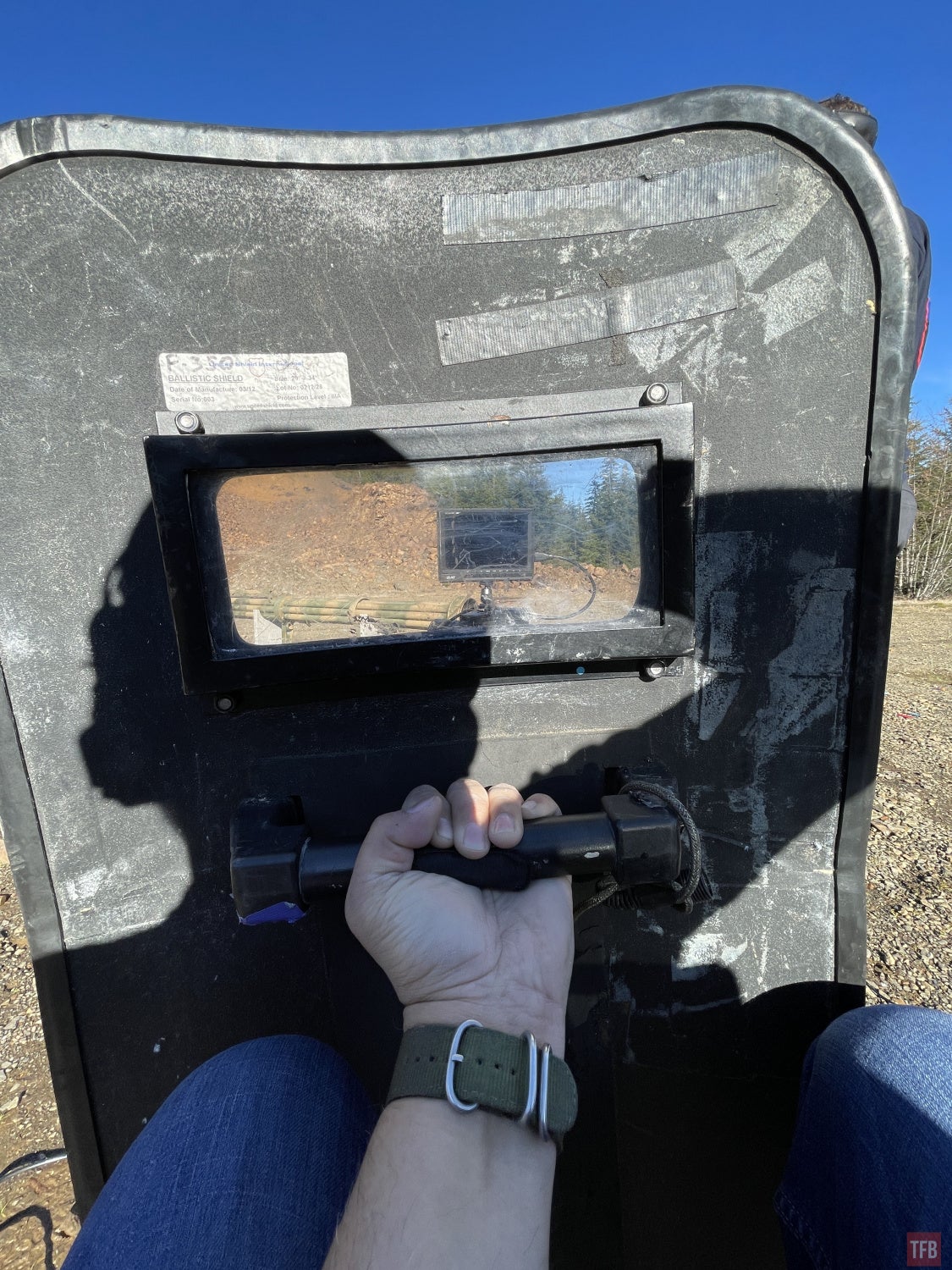

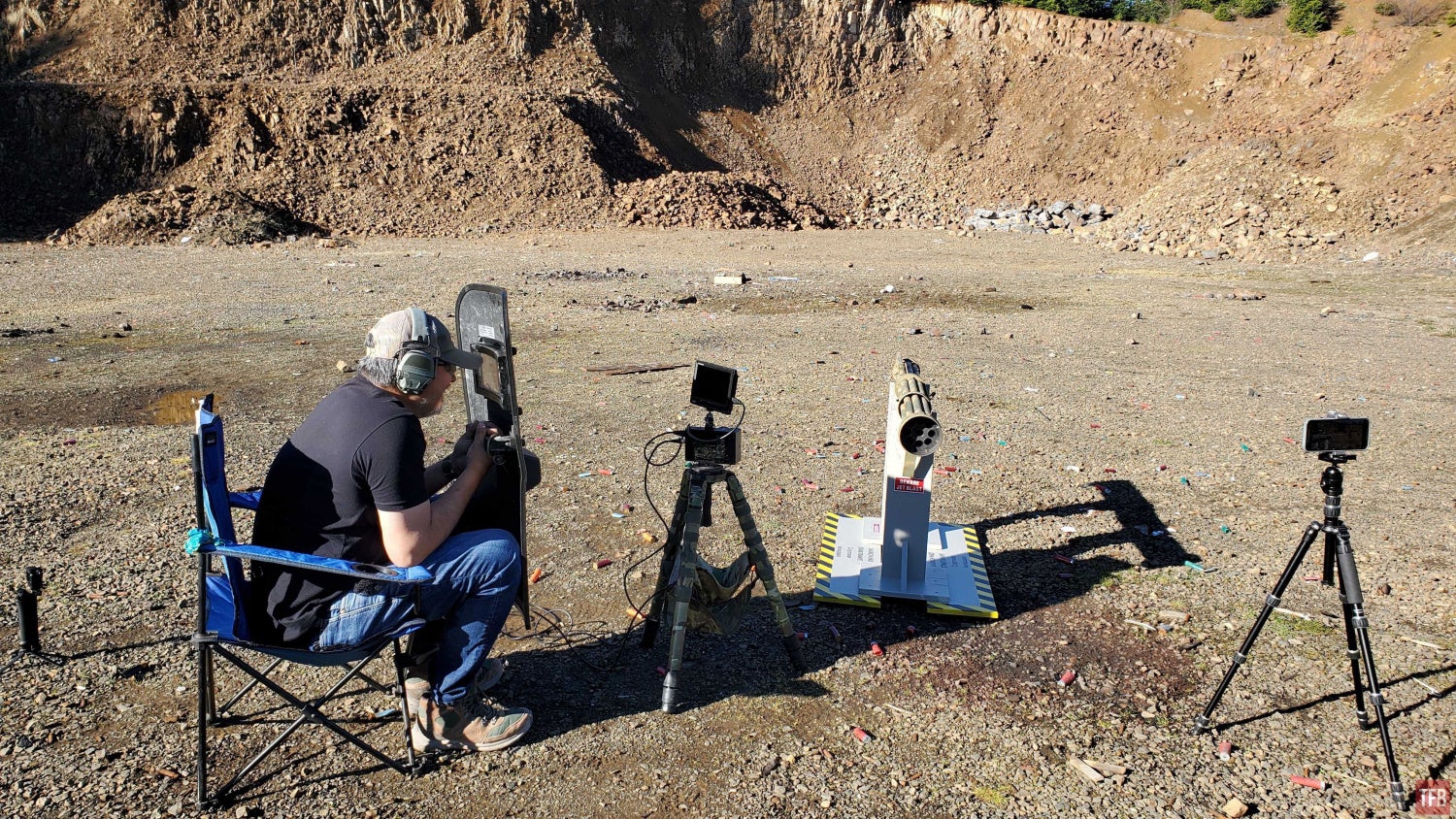
I’m a professional, I know what I’m doing.
We had a trained EMT and firefighter with us just in case.
We reset for a second test using the lighter 100-gram projectiles in the rockets. We wanted to shoot some of the rockets at a target even though they do not have an explosive payload. So we decided on a pyramid of soda cans.

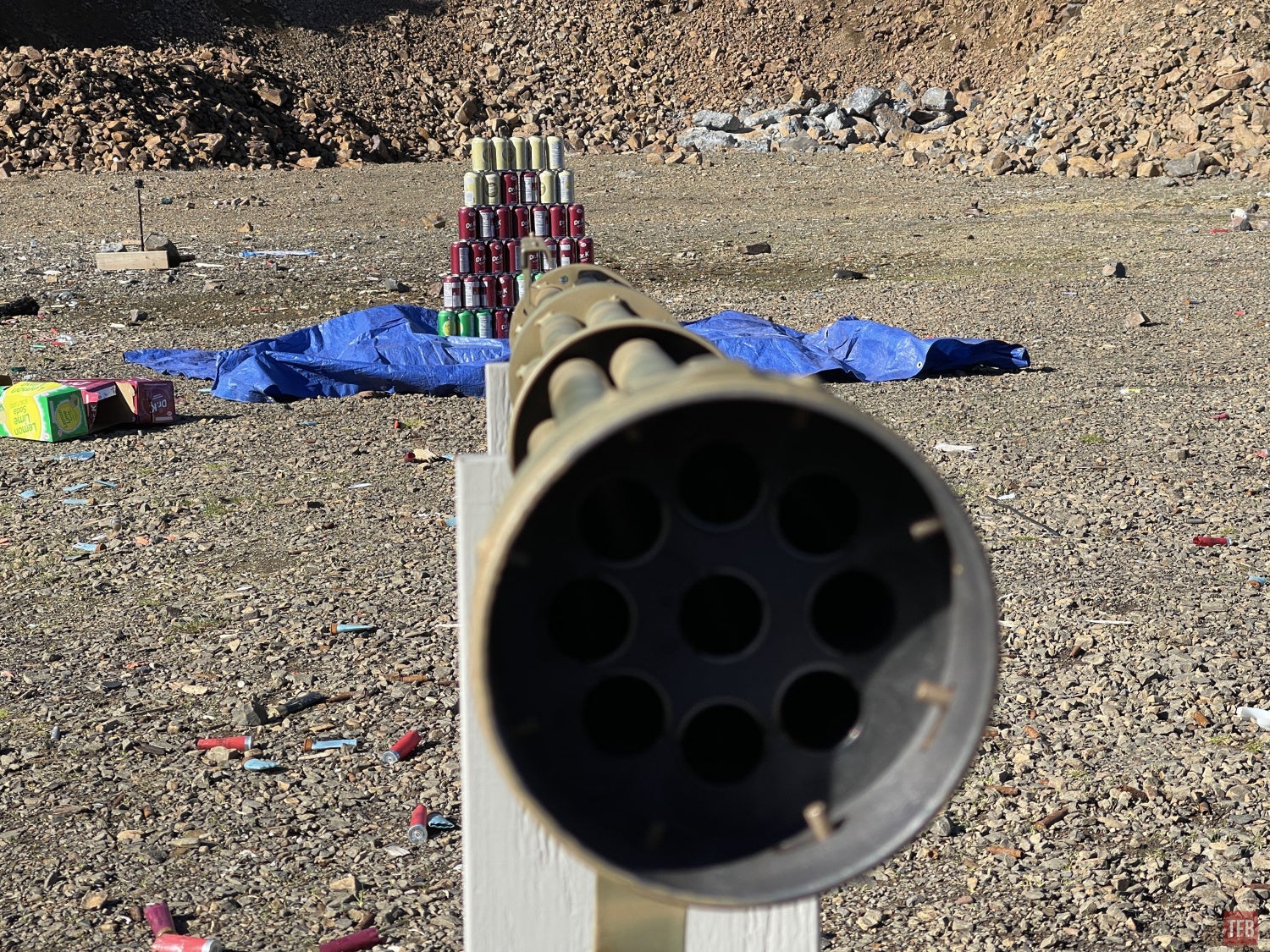
This time I wanted to capture the rocket going through the soda cans which would have been downrange, albeit off to the side. So I used both shields. Having seen the previous rocket test, I was not concerned. It is just a rocket and if something bad happened, the shield would deflect or block anything coming my way. The muzzle velocity is actually very slow. John measured it previously at 111 feet per second. However, this is before the rocket accelerated to its final velocity.

And here is the slow-motion footage I was able to capture. Watch the rocket fly right through the cans.
Here is the soda can. It entered through this side.

Here is the exit hole.

Here is an alternate shot filmed by Lucas D. Watch the rocket nosedive after going through the soda can.
Fliegerfaust Seven Of Nine

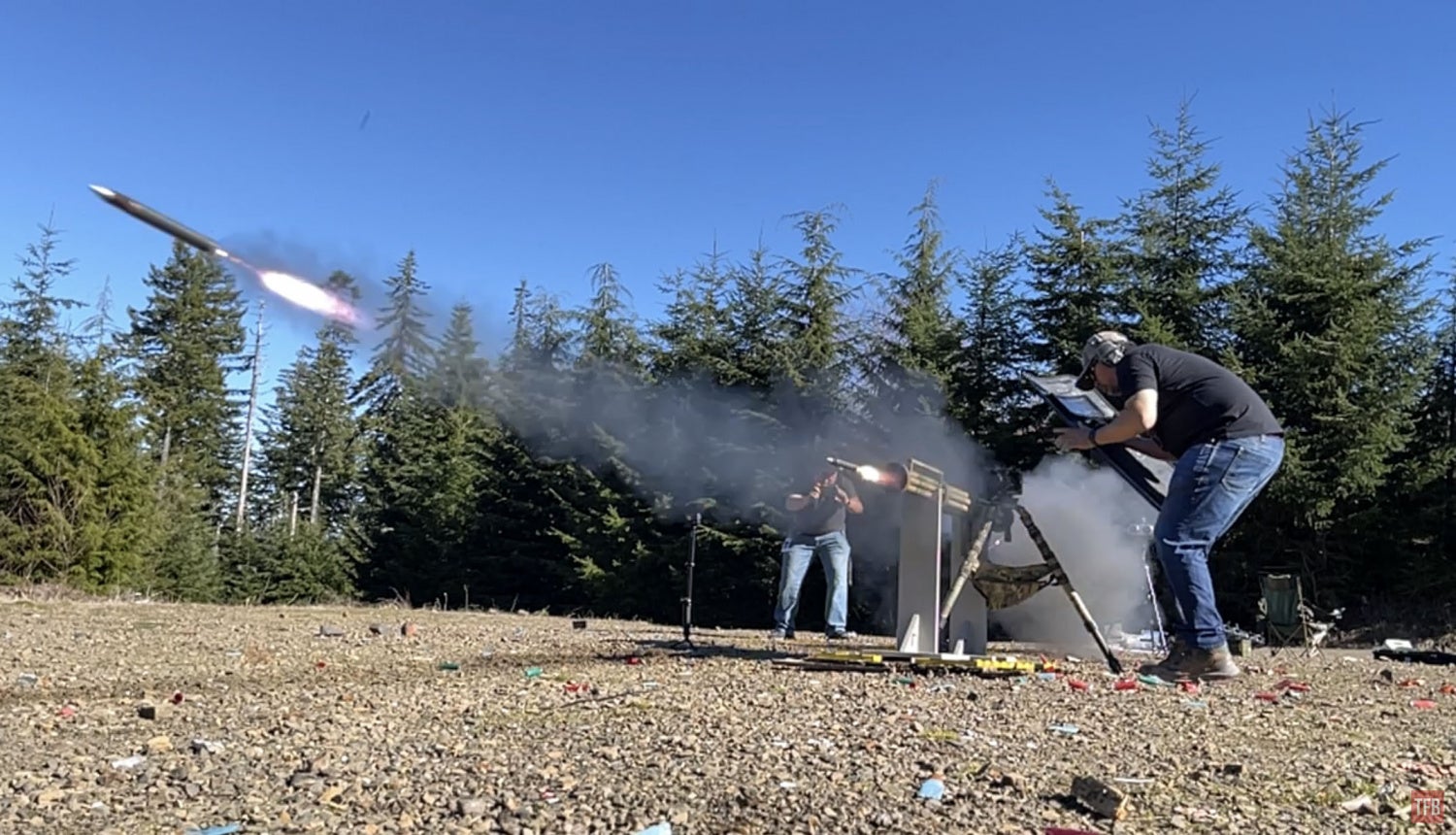
We stepped up to the final test. Loading all nine barrels. I wanted to get more footage of the rockets from behind so I placed the Chronos 1.4 in an almost POV position but this would require me to be right next to the Fliegerfaust launcher. Having seen the previous tests I was not overly concerned and I had the shield.
Watching the video above you can see the rockets did not fire all at once even though John designed this to be volley fire. The e-matches were set to simultaneously ignite however due to the inconsistency of their ignition time to full burn and the time it takes to set off the rocket motors this resulted in the rockets firing in what appears to be a series. However, if you watch the Chronos 1.4 slow-motion footage, you can see how inconsistent each rocket is. Some take longer to leave the launcher than others. There is some considerable time between individual rockets launching compare to others. This is just the nature of homemade rocketry I guess?
We were only able to recover 4 rockets in total. You can see how much damage they incurred from smashing into the rocky backstop. The tubes are made of steel.

Here is what the nozzle looked like after the rocket had fired.

The exhaust is acidic and sort of anodized the steel.

Shoulder Fired Fliegerfaust
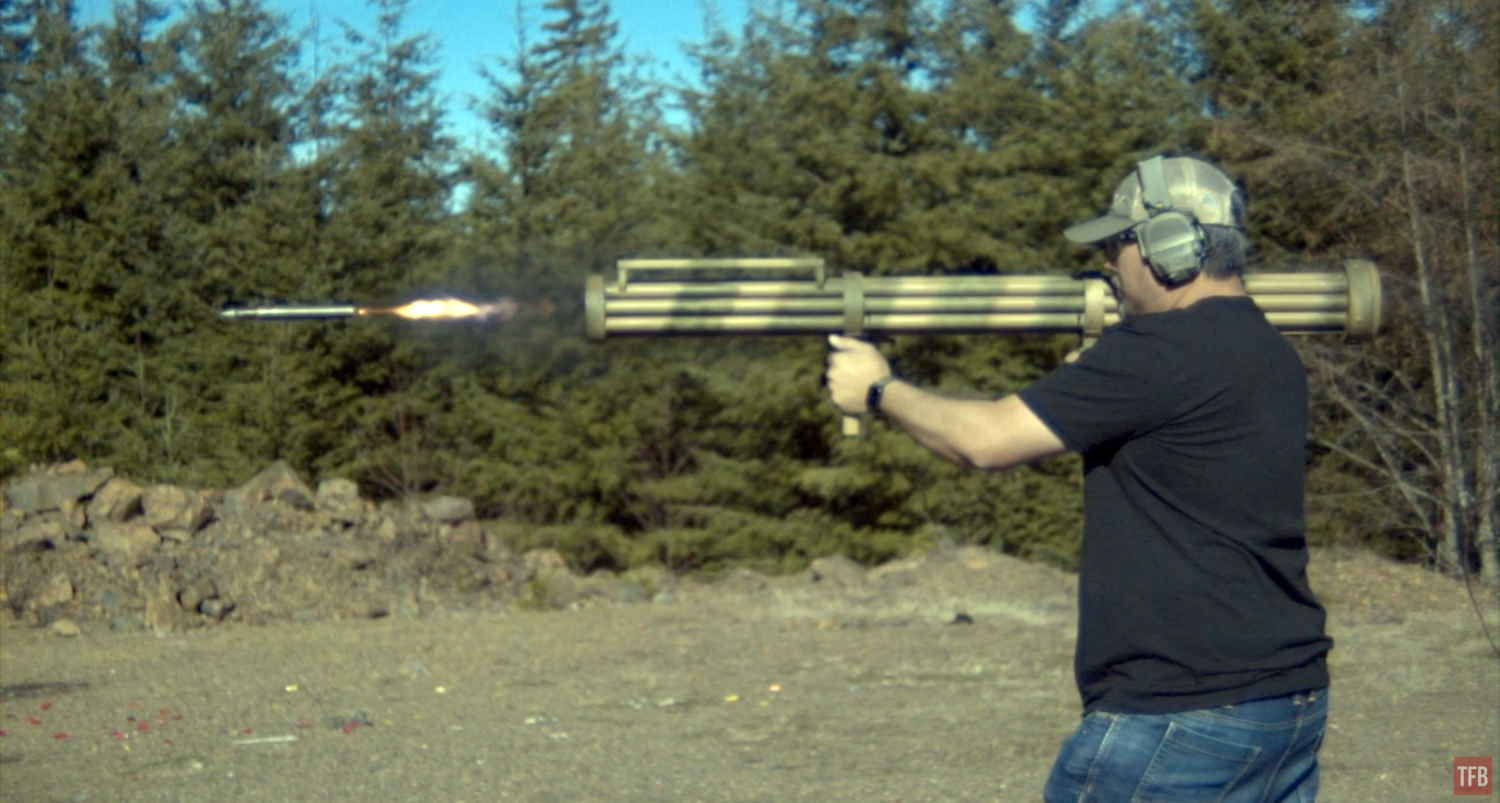
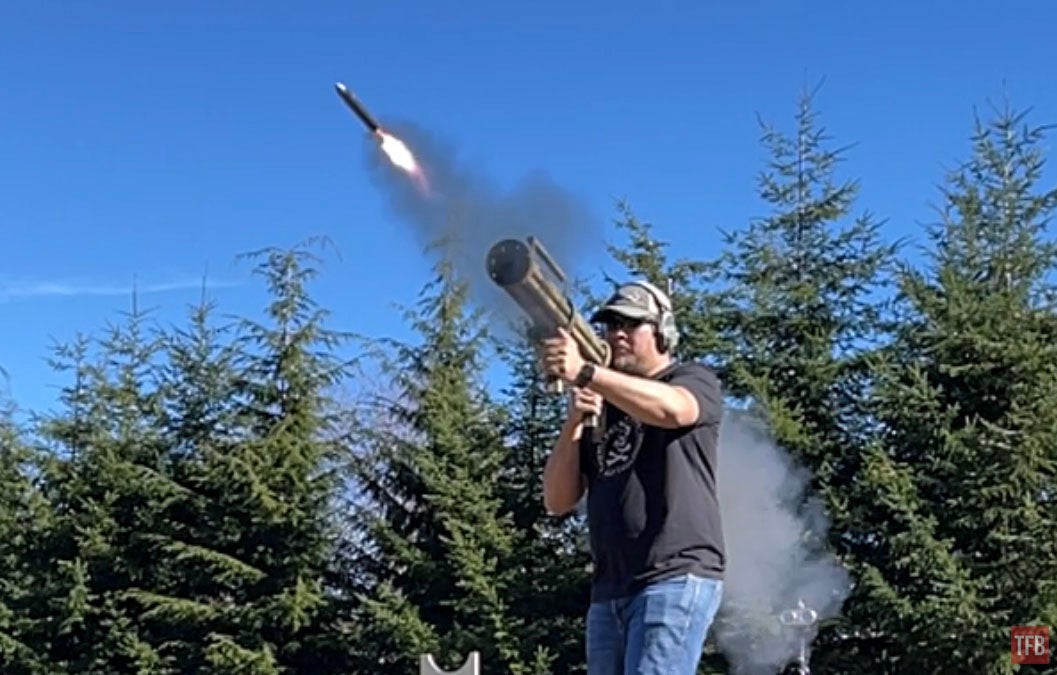
Since only seven of nine rockets fired in the last test, we still had two more rockets. So we decided to shoot one of them and I volunteered to sacrifice my body for science. I held the Fliegerfaust whole John remotely ignited one rocket. I decided it was not necessary to hook up the actual ignition system on the Fliegerfaust launcher since the firing mechanism is not as amazing as actually holding the rocket launcher while a rocket flies out of it. The amount of exhaust in the face was noticeable. I cannot imagine nine rockets firing and shooting exhaust back in my face. I think a proper mask with 3M filters or an Ops-Core SOTR would be a good idea if we ever revisit this.
Panzerfaust!
John still had some inert warheads for his Form 1 Panzerfaust. So he brought them out so we could capture it in slow motion.


For this launch, John used Pyrodex so we mounted the launcher to the stand. One replica warhead had two functional fins. While the other warhead had three loose fins. John decided to launch the one with two working fins.
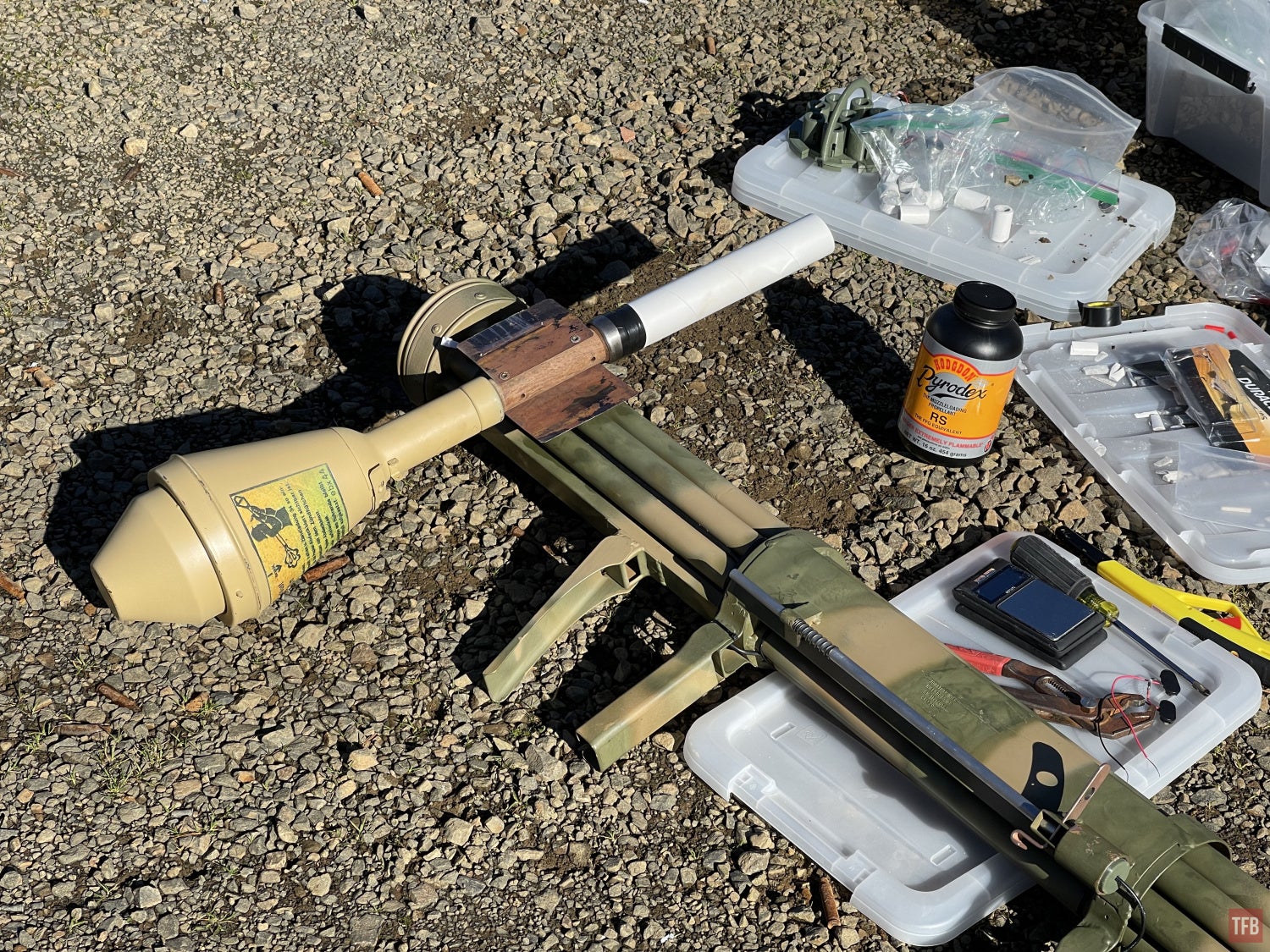

For safety John wired up the Pyrodex powder charge with an e-match so he could remotely launch the dummy warhead.


If you watch the video below, you will notice the nose cone separated in mid-flight but to our surprise, the flying lampshade remained stable in its trajectory.

We were able to recover the used warhead.
John gifted us the warheads. Lucas kept the fired one and I got the one with the loose fins.


Here is John’s video compiling all the footage we shot including some 3D videos that did not turn out that well. (that was my fault)
Final Thoughts On The Fliegerfaust
It is definitely a cool project/journey that John decided to embark on. However, from the small sample size of rockets that we test-fired, and seeing postings about the real Fliegerfaust, it seems like it is not entirely that practical. There are some significant variables that cause the rockets to fly in different directions. The rockets are still accelerating which may also be affecting accuracy. How feasible would this be at taking out an aircraft? I have my doubts. I do not think the rocket has enough fuel to obtain proper elevation to even reach an aircraft let alone have enough energy to deliver a payload.
However, none of that really matters. The Fliegerfaust was a short-lived project even when the Germans were developing it. According to John, not that many were recovered let alone test fired. So I commend him for doing his best to recreate this piece of history and sharing it with the world. I am extremely thankful to John for letting us come document it. It was definitely a historic event that I was happy to be a part of. Thanks to John Wild and all the people who helped him realize his dream.
Just like like his Panzerfaust, John will be coming out with a book detailing his adventure in building his own Fliegerfaust. It will be available on Amazon soon. I’ll post the link in here when it goes live.
 Your Privacy Choices
Your Privacy Choices
